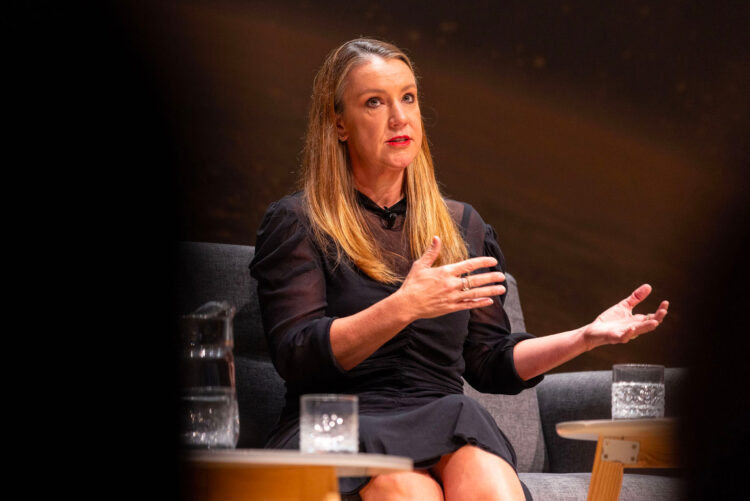Jeremi Gorman exit: will Netflix ever truly embrace ads?

Analysis
Was Netflix’s global ads chief not the right person for the job, or is it the job itself that makes the streaming giant uncomfortable?
“In just one year, she’s built the foundations we need to succeed — attracting world-class brands to Netflix and an incredible team.”
That quote, from a Netflix press release, is the nicest thing that co-CEO Greg Peters had to say about Jeremi Gorman, whose departure as worldwide head of advertising was announced yesterday evening.
Gorman was in the role for just over a year, leading the development of the streaming giant’s advertising business. Netflix launched its Basic with Ads tier in November 2022, and now claims it has more than 10 million global monthly users on its ad-supported plan.
No reason was given for her departure from Netflix, so we’re forced to wonder: was Gorman not the right person for the job, or is it the job itself that prompted the streaming giant to make a change?
It’s notable that Gorman’s replacement, Amy Reinhard, was most recently vice-president of studio operations. In other words, this job as head of advertising is so important that we’re going to give it to someone with, er, no recent experience of doing deals with advertisers or media agencies? This job is so important that we’re giving it to someone who we hired seven years ago to acquire content?
Spare a thought for the army of commercial people Gorman hired in her short time at Netflix — none of whom were considered a better replacement than Reinhard.
Easy come, easy go
As Gorman told in her first industry interview at our Future of TV Advertising conference last December, she raided rival media owners to build up a nascent ad sales team, with senior hires coming from Snap, Amazon, Google, TikTok, GroupM, NBC, and Disney. Gorman said she had chosen people who had worked in digital and traditional television “on purpose” to “bring those two thought groups together”.
It’s worth remembering that Gorman was a rush hire herself; she joined Netflix from Snap, where she spent four years as chief business officer. She previously worked at Amazon Advertising, becoming head of advertising sales in 2015.
But then the whole enterprise of selling ads on Netflix has been a rush job from the start. Netflix announced it would launch a cheaper subscription tier with ads in response to a very difficult earnings quarter in spring 2022. It hastily announced the move as it reported its first year-to-year decline in subscribers in more than a decade.
The problems it faces then remain now: after having the streaming field virtually to itself for more than a decade, Netflix now faces stiff competition from Disney, Paramount, and regional TV networks that have improved their streaming offerings, including ITV and Channel 4 in the UK.
And, at a time of stubbornly high inflation, raising the prices of subscriptions is tricky. Not just due to an increase in competition, but because consumers’ purchasing power has declined significantly. This is why Netflix and Disney have, this year, opted for more ‘polar’ pricing strategies which essentially force consumers to either choose to pay more for ad-free or watch ads to get it cheaper.
None of which has played well in Gorman’s favour, when she was forced to defend Netflix’s rush into advertising. Armed with little detail to give about sales strategy, she opted to talk to the industry about hopes and dreams and other warm, fuzzy ideas.
The “dream”, as Gorman told FTVA in London, was for Netflix to be seen as a marquee advertising destination that is thought of as highly as Times Square, the Piccadilly Lights, the Super Bowl or the World Cup.
For Gorman, she wanted to ensure that “people want to come to what we’re doing because the advertising is so good, so topical, so relevant, so compelling”.
Defend it like Beckham
Fast forward to summer 2023, and the reality was less idyllic. Netflix was forced to announce a restructure of its deal with partner Microsoft, the tech giant employed to build the advertising architecture on the streaming platform. Netflix wanted to rework the agreement to reduce the revenue guarantee due to slowing growth of the ad tier, the Wall Street Journal revealed, because executives were frustrated that Microsoft has not sold more ad inventory.
Well, that’s one way to look at it.
Another would be to question a commercial strategy in which you’ve spent over a decade building a global streaming powerhouse off the back of being ad-free and amassing a vast archive of generally high-quality TV content, to the point where you can hubristically start talking about “sleep” being your main competitor.
What does it then say to advertisers when you propose: “hey guys, you know all those people who either can’t afford Netflix or don’t think it’s worth $10.99 a month? How would you like to advertise to them — and only them? Do they actually have any money to buy your product or service? Hmm, we hope so!”
And that’s even before getting into the technical detail, how easy would it be to insert ads into a huge back catalogue of television content which was expressly created not to feature advertising?
The answer, Gorman told us in the interview, is AI. Of course it is.
Netflix, she said, was using artificial intelligence to “insert ads in the right places” in shows that were not written for ad breaks, such as at the end of scenes and when the screen fades to black.
Netflix ads chief: ‘the way we’ve launched is not where we want to be’
Most tellingly, she summarised the Netflix entry into advertising this way: “The way that we launched the business is not representative of what we want the future of the business to be. It’s just been so quick that we wanted to ensure that we had the most standard units and that we are getting into the standard measurement business. I think we have a really big opportunity to be that middle [between linear and connected TV].”
I wasn’t able to attend Netflix’s public event with the advertising community at Cannes Lions last June, but I was led to believe by those who had that advertisers were being told much of the same: we’re working on things, give us time, jam tomorrow etc. Given that Cannes Lions is the world’s biggest ad industry festival, you’d think Netflix would have more to say, but by all accounts it was the appearance of David Beckham, there to promote an upcoming documentary (which just so happens to premiere today), that was Netflix’s most interesting stunt that week.
Which goes to the heart of Netflix’s apparent issue: are we really serious about ads?
In her own words in the exit announcement, Gorman said: “My passion is scaling businesses from the early stages, which I have done many times…. We’ve built a world-class team and laid the foundations needed to create a forever ads business. The stories at Netflix are second-to-none, and brands are eager to be a part of that zeitgeist.”
Even to the last, the record is questionable. Just 2% of Netflix and Disney+ subscribers in the US are on the cheaper, ad-supported tiers each streaming giant launched last winter, research by Ampere Analysis revealed in August.
Those numbers suggested Netflix and other subscription video-on-demand (SVOD) services — that were late to launch ad tiers — are facing a much harder time building advertising businesses than those, like NBC’s Peacock or ITVX in the UK, that have incorporated advertising from the start.
 Omar Oakes is editor-in-chief of The Media Leader and leads the publication’s TV coverage.
Omar Oakes is editor-in-chief of The Media Leader and leads the publication’s TV coverage.
‘100% Media 0% Nonsense’ is a weekly column about the state of media and advertising. Make sure you sign up to our daily newsletter to get this column in your inbox every Monday.
NEXT WEEK: Omar will interview Havas CEO Yannick Bolloré, S4 Capital and WPP founder Sir Martin Sorrell, and The Sun EVP publisher Dominic Carter at The Future of Media in London.




